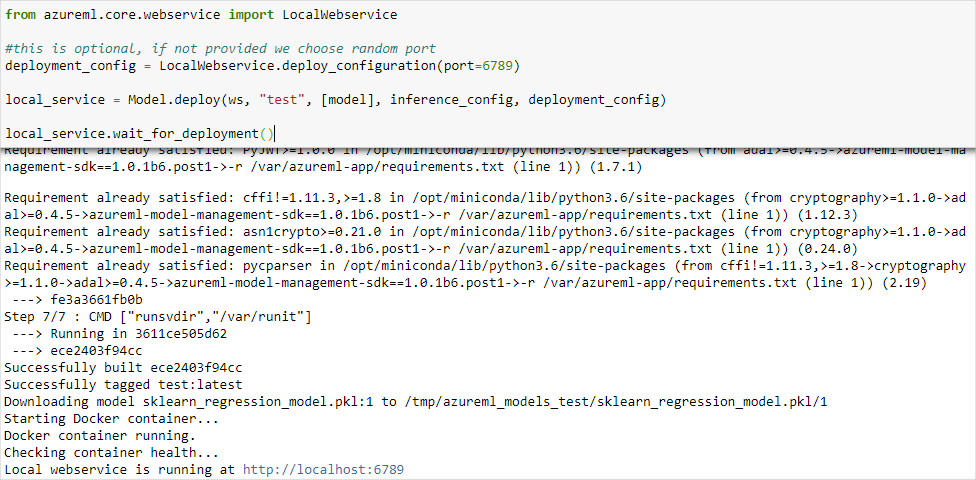모델을 로컬로 배포
Azure Machine Learning을 사용하여 모델을 Azure Machine Learning 컴퓨팅 인스턴스에 웹 서비스로 배포하는 방법에 대해 알아봅니다. 다음 조건 중 하나에 해당하는 경우 컴퓨팅 인스턴스를 사용합니다.
- 모델을 빠르게 배포하고 유효성을 검사해야 합니다.
- 개발 중인 모델을 테스트합니다.
팁
컴퓨팅 인스턴스의 Jupyter Notebook에서 동일한 VM의 웹 서비스로 모델을 배포하는 것은 로컬 배포입니다. 이 경우 '로컬' 컴퓨터는 컴퓨팅 인스턴스입니다.
참고
Azure Machine Learning 엔드포인트(v2)는 향상된 간단한 배포 환경을 제공합니다. 엔드포인트는 실시간 및 일괄 처리 유추 시나리오를 둘 다 지원합니다. 엔드포인트는 컴퓨팅 유형 간에 모델 배포를 호출하고 관리할 수 있는 통합 인터페이스를 제공합니다. Azure Machine Learning 엔드포인트란?을 참조하세요.
필수 구성 요소
- 컴퓨팅 인스턴스가 실행되는 Azure Machine Learning 작업 영역. 자세한 내용은 시작할 리소스 만들기를 참조하세요.
컴퓨팅 인스턴스에 배포
로컬 배포를 보여주는 예제 노트북은 컴퓨팅 인스턴스에 포함됩니다. 다음 단계를 사용하여 노트북을 로드하고 모델을 VM에 웹 서비스로 배포합니다.
Azure Machine Learning studio에서 "Notebooks"을 선택한 다음 "Sample notebooks"의 how-to-use-azureml/deployment/deploy-to-local/register-model-deploy-local.ipynb를 선택합니다. 이 노트북을 사용자 폴더에 복제합니다.
1단계에서 복제된 노트북을 찾고, 노트북을 실행할 컴퓨팅 인스턴스를 선택하거나 만듭니다.

노트북에는 서비스가 실행되는 URL 및 포트를 표시합니다. 예들 들어
https://localhost:6789입니다.print('Local service port: {}'.format(local_service.port))이 포함된 셀을 실행하여 포트를 표시할 수도 있습니다.
컴퓨팅 인스턴스에서 서비스를 테스트 하려면
https://localhost:<local_service.port>URL을 사용합니다. 원격 클라이언트에서 테스트하려면 컴퓨팅 인스턴스에서 실행되는 서비스의 공용 URL을 가져옵니다. 공용 URL은 다음 수식을 사용하여 확인할 수 있습니다.- Notebook VM:
https://<vm_name>-<local_service_port>.<azure_region_of_workspace>.notebooks.azureml.net/score. - 컴퓨팅 인스턴스:
https://<vm_name>-<local_service_port>.<azure_region_of_workspace>.instances.azureml.net/score.
예제:
- Notebook VM:
https://vm-name-6789.northcentralus.notebooks.azureml.net/score - 컴퓨팅 인스턴스:
https://vm-name-6789.northcentralus.instances.azureml.net/score
- Notebook VM:
서비스 테스트
실행 중인 서비스에 샘플 데이터를 제출하려면, 다음 코드를 사용합니다. service_url 값을 이전 단계의 URL로 바꿉니다.
참고
컴퓨팅 인스턴스에서 배포를 인증하는 경우 Azure Active Directory를 사용하여 인증을 수행합니다. 예제 코드에서 interactive_auth.get_authentication_header()를 호출하면 AAD를 사용하여 인증하고, 컴퓨팅 인스턴스에서 서비스를 인증하는 데 사용할 수 있는 헤더를 반환합니다. 자세한 내용은 Azure Machine Learning 리소스 및 워크플로에 대한 인증 설정을 참조하세요.
Azure Kubernetes Service 또는 Azure Container 인스턴스에서 배포를 인증하는 경우 다른 인증 방법이 사용됩니다. 자세한 내용은 웹 서비스로 배포된 Azure 컴퓨터 모델에 대한 인증 구성을 참조하세요.
import requests
import json
from azureml.core.authentication import InteractiveLoginAuthentication
# Get a token to authenticate to the compute instance from remote
interactive_auth = InteractiveLoginAuthentication()
auth_header = interactive_auth.get_authentication_header()
# Create and submit a request using the auth header
headers = auth_header
# Add content type header
headers.update({'Content-Type':'application/json'})
# Sample data to send to the service
test_sample = json.dumps({'data': [
[1,2,3,4,5,6,7,8,9,10],
[10,9,8,7,6,5,4,3,2,1]
]})
test_sample = bytes(test_sample,encoding = 'utf8')
# Replace with the URL for your compute instance, as determined from the previous section
service_url = "https://vm-name-6789.northcentralus.notebooks.azureml.net/score"
# for a compute instance, the url would be https://vm-name-6789.northcentralus.instances.azureml.net/score
resp = requests.post(service_url, test_sample, headers=headers)
print("prediction:", resp.text)